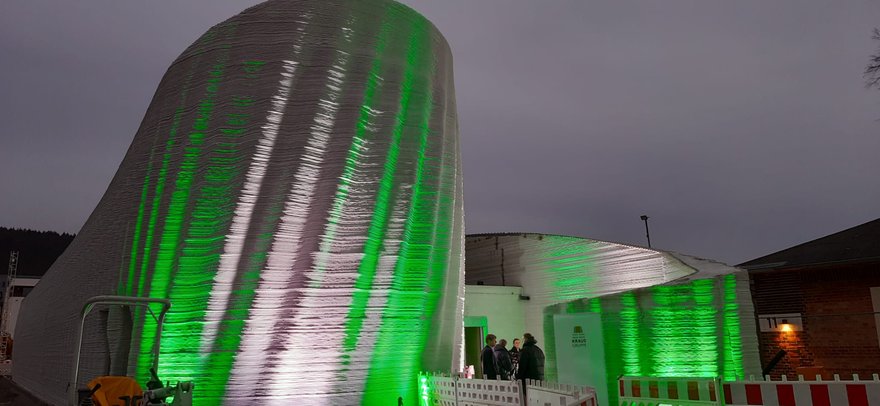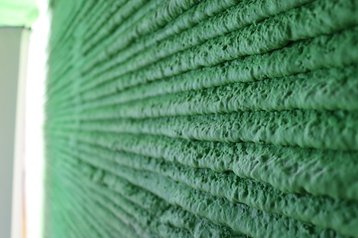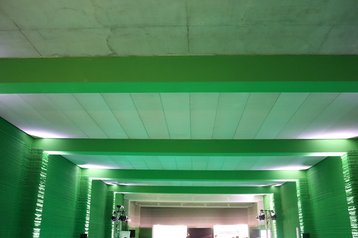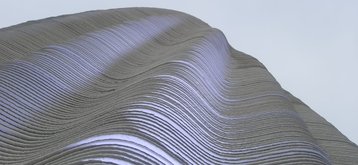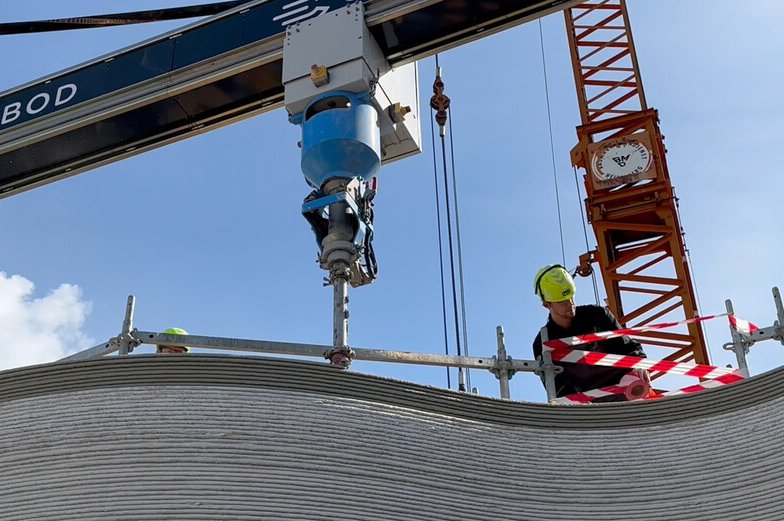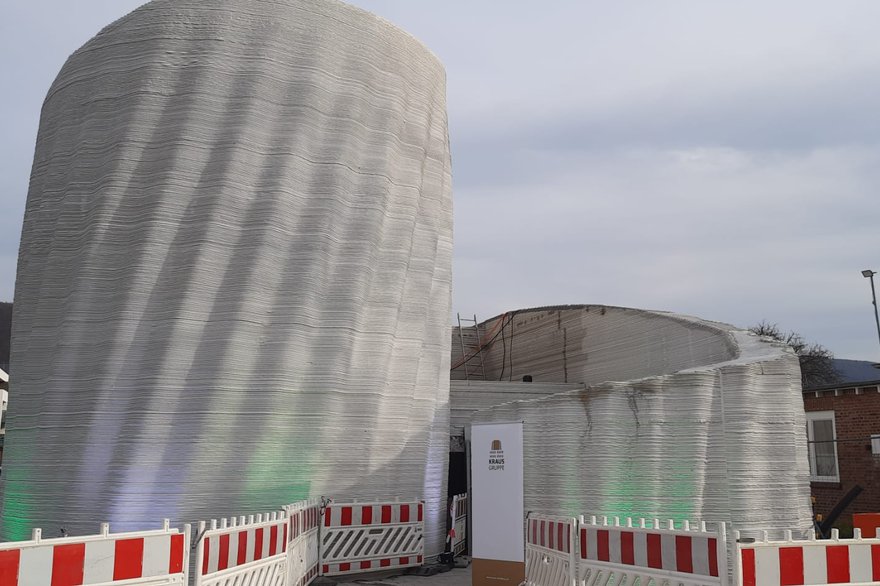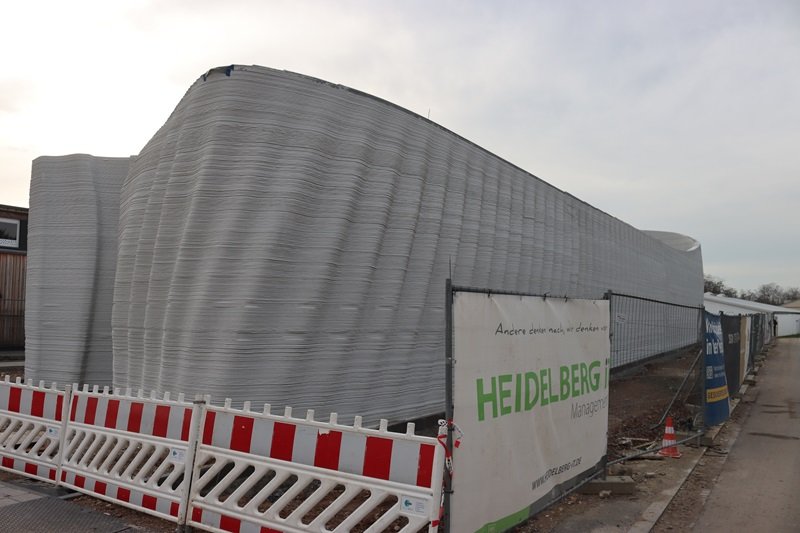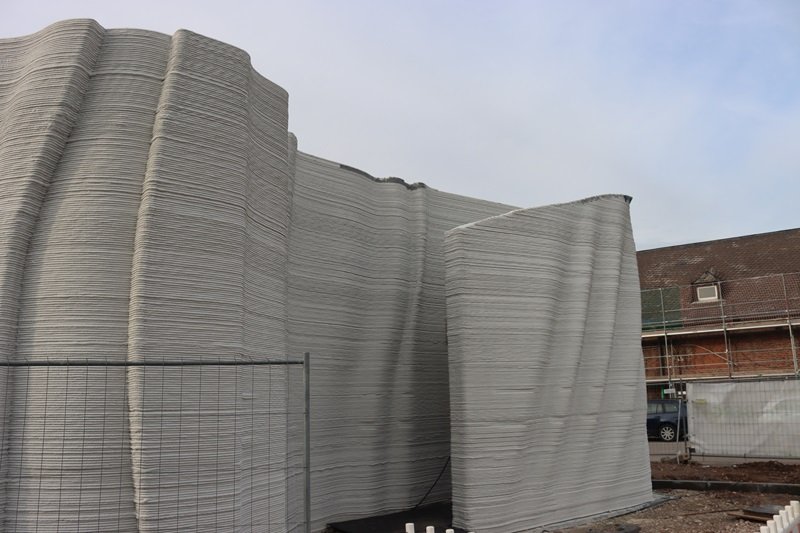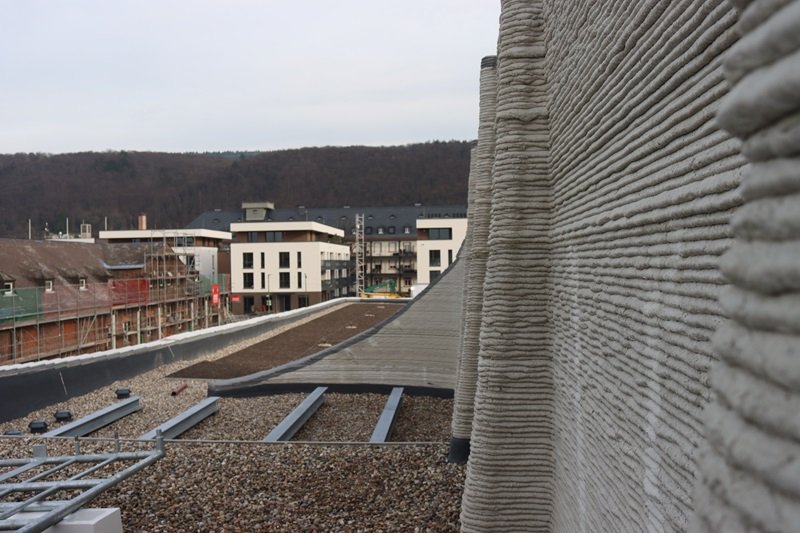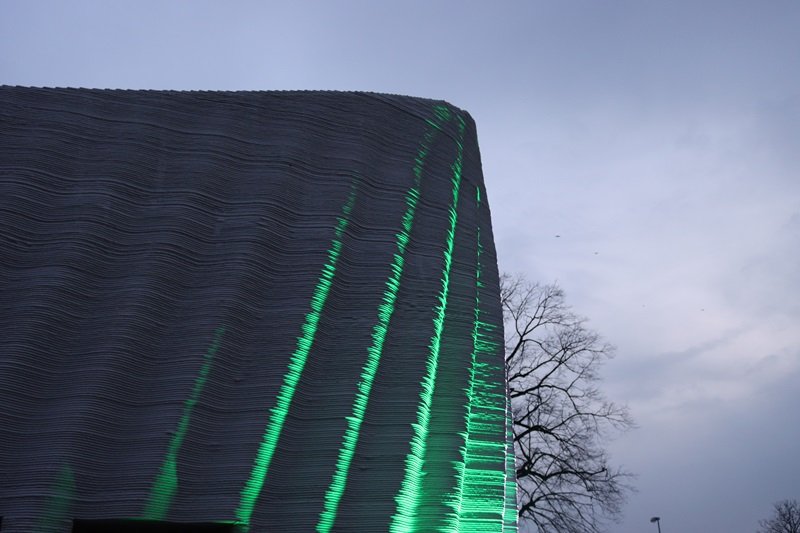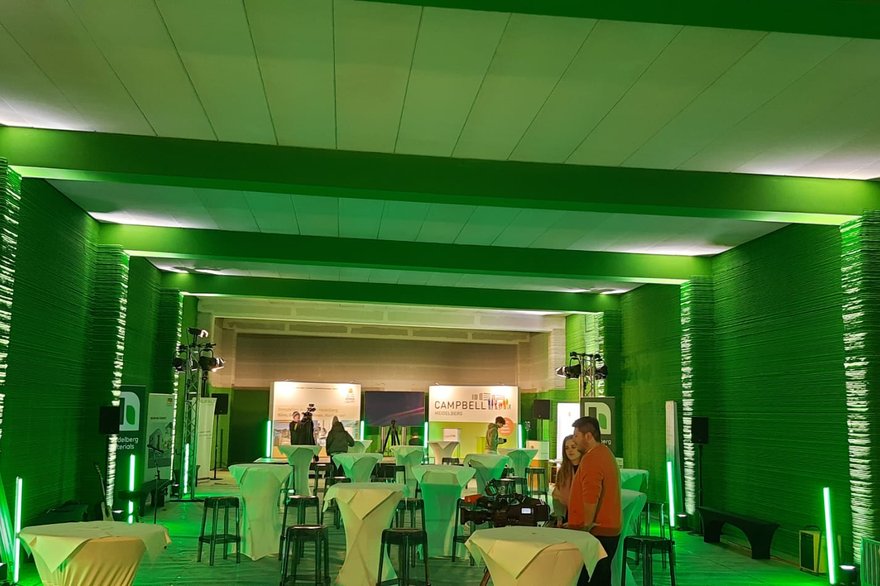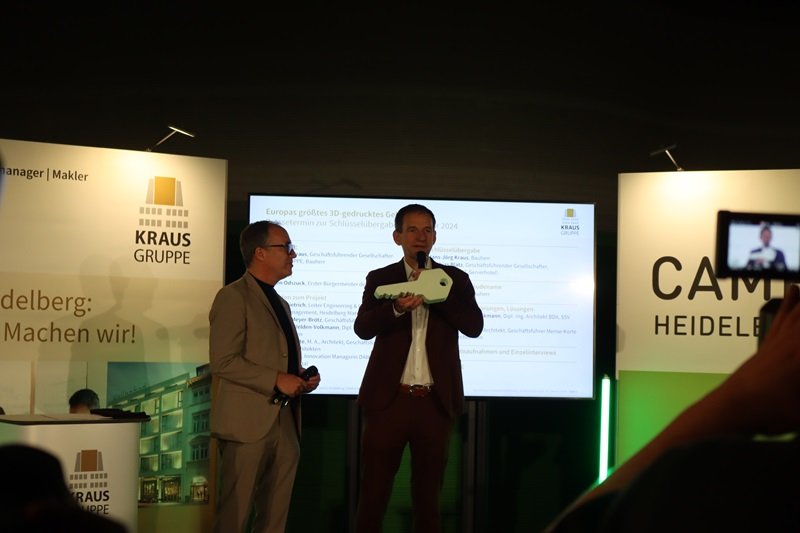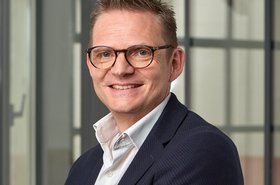Walking down the street of a former US Army Barracks in the quiet German city of Heidelberg, one may come across a strange grey building. Nestled between some pre-WWII offices and a kindergarten, the windowless concrete shell seems oddly out of place.
While the location might seem a little odd on paper, in-the-know DCD readers will say a windowless concrete building sounds like your run-of- the-mill data center. But this one is different.
For one, it has no corners. Its rounded external shell undulates and twists along the length of the property. And, instead of traditional blocks or precast walls, this data center’s fascias were built up in layers of liquid cement.
Known as the ‘Wavehouse Campbell Heidelberg,’ this building is the world’s first 3D printed data center.
3D printing a data center
Heidelberg, located around 50 miles south of Frankfurt on the river Neckar, is a city of around 160,000 people in the state of Baden-Württemberg. It is known for having a reputable university and several high-quality scientific research facilities.
Fittingly, the city is home to Heidelberger Druckmaschinen, a 170-year-old company and one of the world’s largest manufacturers of printing presses. The fact the city is now also home to an early landmark of 3D printing, however, is just a chance occurrence made possible by a few local businessmen.
Originally, local managed IT services provider Heidelberg iT and real estate firm Kraus Gruppe planned to develop a traditional right-angled data center on the site.
However, after reading about a 3D-printed residential building built by local materials firm Heidelberg Materials (formerly HeidelbergCement), Hans-Jörg Kraus, managing partner of the Kraus Group, decided to phone his longtime friend Mattias Blatz at Heidelberg iT and ask if he wanted to 3D print the facility instead.
When asked why he wanted to 3D print a building, Kraus smiles at DCD and simply says; “I am like a child. I love to make new things. It's beautiful to see.”
He continues: “I read in a real estate article that Heidelberg Materials printed a family house. I knew I had to build a data center for Mattias, and thought it would be perfect to print. Then I spoke with people I know from Heidelberg Materials and I said ‘I want to print this building.’”
“We had planned a data center here,” adds Blatz, owner of Heidelberg iT. “And then my friend [Kraus] had the idea with the 3D and I said yes, I want to do it.
“I was very excited because I’ve known him so long that I know when he has an idea, I trust him.”
Though officially launched in 2007 after merging with MEG Kommunikationssysteme GmbH, Heidelberg iT can trace its roots back to the launch of its first data center in cooperation with MVV Manet GmbH in 2001. A second facility was launched in 2016.
The company is set to launch a third – traditionally constructed – data center in the coming months that will offer 500kW – the same as the 3D printed facility. But that unremarkable site holds few accolades compared to its 3D-printed compatriot.
The Wavehouse simultaneously has the titles of Europe’s largest 3D printed building, the world’s first purpose-built 3D printed industrial building, and the world’s first 3D printed data center.
The parametric design of the Wavehouse is in stark contrast to another data center recently launched nearby; a 2MW facility from InfraRed Capital-backed Nexspace located less than a mile away and launched in late 2023.
That building – boasting smooth green and white panels and right angles at every corner – is the only real competition Heidelberg iT faces in a city not known for its data center developments.
Heidelberg is amongst the warmest regions of Germany – warm enough to grow grapes, almonds, figs, and palm trees. Blatz says the relatively small local market, temperature, and proximity to Frankfurt mean Heidelberg doesn’t need a large data center ecosystem and would struggle to support any hyperscale developments.
“There is only one reason to build a data center in Heidelberg, for the customers,” says Blatz. Several healthcare organizations based in the area have sensitive instruments with low latency requirements – he gives MRI equipment as an example – meaning they prefer to keep IT infrastructure local.
“There is a small business economy,” he adds. “It would make no sense in the hottest city in Germany to build a data center for other things; its better to go Iceland, Sweden, Austria, or wherever, but not in Heidelberg.”
The Wavehouse
Traditionally, data centers are either built using masonry blocks or ‘tilt-up construction’ – where concrete wall panels are cast on-site and 'tilted' into position using cranes. 3D printing, however, uses a printer to extrude layers of concrete upon one another, building the walls up layer by liquid layer.
The Wavehouse data center is situated to the south of the city center, on the site of the former US Army Barracks. Previously known as Baufeld 5 (literally translating to "Construction site 5”) prior to construction and located at Billie-Holiday-Strasse 7 in Baden-Württemberg, the single-story building totals just under 600 sqm (6,600 sq ft); 54 meters long, 11 meters wide, and 9 meters high.
Partners on the project include Peri 3D, which is part of the scaffolding firm Peri Group, as well as architecture firms Mense-Korte and SSV, and Heidelberg Materials.
Peri began work on the facility last year using a Cobod BOD2 3D construction printer. The facility was printed over 30 days using around 450 tons of printing concrete from Heidelberg Materials. Printed between late March and mid-August 2023, the facility was originally due to take 140 hours, equivalent to printing four square meters (43 sq ft) of building per hour.
Peri3D tells DCD the total print time was actually around 172 hours over 30 days during this period. Blatz jokes the print took longer due to the amount of press interest the project generated: “Too many news magazines wanted to see how we print! But it was as a pleasure to show all the TV stations; we’d print for an hour or two a day.”
At the time of writing, construction on the shell had been completed and Heidelberg iT will now build out the white space and electrical room. The data center will offer 500kW and have capacity for around 100 racks. The fit-out is expected to be complete towards the end of the summer.
The IT firm has a long-term lease on the site, which Blatz says has a planned lifespan of 20 years, though he hopes it could last “much longer” than that. At the time of writing, the company didn’t have an anchor tenant for the facility, but discussions were ongoing.
Heidelberg iT plans to install solar panels on the roof of the facility – around 80kW worth – and will be procuring energy from hydroelectric sources to offset its remaining energy use.
Blatz says his company generally has more solar panels at its data centers – such as whole wall deployments – but was limited by local planning regulators for this project. Waste heat for the facility is due to be sent to buildings in the surrounding area once the district heating network is set up.
A learning experience for everyone
Jan van der Velden-Volkmann of SSV Architekten notes his firm hadn’t had any prior 3D printing experience before the Wavehouse, but Mense-Korte had been involved in some previous projects, which was useful for permitting.
“With this technology, we had the chance to try some more organic forms that are normally not possible,” he says. “That was the aim for us, to test how far can we go with it.”
“We had the chance to make this organic form with the waves on the facade; it's a very heavy block, but the form seems to be light.”
He notes that because this was a novel design using a novel technology, close collaboration with Peri 3D, Mense-Korte, and Heidelberg Materials during the design process was key.
“The important thing is you have to answer various questions very early in the process. Normally we try, and then have a back-and-forth to change things. With this it is very challenging; you have to do a lot in the early stages because it's hard to change things afterwards.”
Certification for much of the facility has been a challenge. Most of the materials and designs for these kinds of buildings haven’t been proven out. And so the companies had to over-engineer in some places – the internal hall features multiple protruding support columns that Blatz said the regulators required. The testing required to approve the columnless design would likely have taken several years.
While there were design limitations, van der Velden-Volkmann says working with the local government overall was “very constructive” during the project. Part of this was because the volume and planned use for the site was largely the same as the previously planned cuboid data center, but also because officials were keen for the plaudits.
“They were very interested in getting such a building in Heidelberg,” adds van der Velden-Volkmann. “The counselor himself said 'we want to have this,' so there was pressure enough [to get it through].”
Heidelberg iT will be targeting certification from TÜVs – a German technical testing & certification organization – to show the facility is secure and resilient, alongside Blue Angel green certification to show environmental chops.
The foibles of printing a data center
The handover ceremony in late January 2024 was attended by around 100 people, including members of the construction, materials science, and national press – a far cry from some data center events with a handful of the same faces over and over.
DCD was disappointed, however, that the oversized key handed over during the ceremony was made of styrofoam and not 3D printed; an opportunity missed. But press of all stripes have been regular visitors to the site.
“We thought we would be in one magazine, and a newspaper here,” says Blatz. “We never expected that we would go through the world; that the Chinese might want a picture from us. A Korean team came and wanted to see it. We have had Americans come here. Indian TV as well. We are proud that we have that interest.”
The walls of the Wavehouse comprise two lines of built-up concrete a few inches apart – also known as a double-skin wall – and linked by steel rods. In residential developments the space between the two rows would be filled with insulation; here, it has been filled with more concrete as there’s no need for more heat to be kept in and it improves wall strength.
Due to limitations around the gantry frame that holds the printer, the Wavehouse was printed in three segments. Connecting pieces were then printed and put into place to seal the facility – the seams between segments are noticeable on the inside once pointed out.
During the design phase, Blatz says some of the software the architecture firms were using were struggling to work with some of the shapes and angles being proposed, and required additional programming to accommodate these calculations into their 3D models.
“They figured that out,” he says. “They also spent a lot of time and money in the way to find out how it can work out and how they can calculate if these walls are thick enough.”
3D-printed buildings use far less metal than traditional concrete builds and often don’t require large amounts of rebar frames. Blatz said this meant there is far less static for the Wavehouse compared to a traditional data center.
Blatz has also made a deliberate design choice around the raised floor learned from a previous facility. A one-meter recess has been cut into the slab for raised floor, but the company has opted not to put any thermal insulation in there (it has been waterproofed).
As a result, the colder ambient temperature of the ground reportedly provides 20kW of free cooling to the facility. Only cutting the recess where racks will actually go, rather than right up to the wall, also improves air circulation.
A painting robot from DAW Deutsche Amphibolin-Werke by Robert Murjahn was used for painting the interior – painted Heidelberg iT’s shade of green to match Blatz’s neon trainers. The outside, however, will remain concrete grey – though living walls are set to be planted at regular intervals along the length of the facility.
While the facility won’t have perimeter fences – a limitation of its location – the site will feature multiple gates at its entry points. The thick walls also add further security.
On the flip side, Blatz said there were challenges around ensuring the roof of the facility (flat and not 3D printed) was water-tight against the ripples of the 3D printed layers of the building. Likewise, fitting the fireproof doors was also a challenge.
Blatz notes that printing is made more difficult in heavy rain, and that it was best not to leave too long between printing sessions on segments.
“We learned a lot,” Blatz says. “[Some of it was] a lot more work than we thought.”
While he didn’t provide a number, Mattias said the Wavehouse has cost around double the price of the other, traditionally-built, data center the company is opening – partly because the original plans for a data center on this site were already complete and had to be reworked.
He says, however, they would likely save more money on future builds based on what they’ve learned during the project.
A one-off data center?
The Wavehouse may remain the only 3D-printed data center for the foreseeable future.
While there was one on the cards in the US, the developer opted instead for a warehouse retrofit. Technology constraints still limit the size of any printed building, and regulators are still wary of largely untested designs and materials.
In the US, EdgeCloudLink (ECL) was originally to offer hydrogen-powered off-grid modular data centers, built in 1MW units, using 3D printing construction.
ECL previously said it was planning to partner with a local 3D printing construction
firm for its initial build, and later buy its own 3D printers. For its first facility, however, the company opted to retrofit an existing warehouse instead of printing a facility, and is looking to focus more on retrofitting existing buildings for now, potentially returning to the 3D printing concept in future.
“I personally believe that the conversion of buildings is probably more powerful than doing the 3D printing,” company founder Yuval Bachar recently told DCD. “There's so much empty space and it's going to waste right now.”
Given the current construction limits around 3D printing in terms of physical size, it seems that printing a hyperscale-sized or high ceiling multi-story data center is out of reach for now. For a developer willing to test the regulatory limits with local planning boards, an Edge developer could well find utility in this new way of building. But industry optimism remains.
“The interesting question is what comes afterwards,” says SSV’s van der Velden-Volkmann. “The technology is very new, so you have to go step-by-step to get more knowledge and then to see what comes out next.”
While the Wavehouse is the first 3D printed data center, Peri3D is keen that it won’t be the last.
“I think that IT infrastructure and respective buildings can absolutely be something that 3D printing could be used for. I think we've done it now,” says Lukas Bischofberger, corporate & marketing communications specialist at Peri 3D.
“We don't necessarily think that in 20 or 30 years, every building is coming out of a 3D printer. For some building types, other ways of construction can make more sense. But we still think there's a lot of projects that can really benefit from this.”
Both Blatz and Kraus remain keen on the concept. Blatz says he would print another data center in future, while Kraus is already planning his company’s next 3D build; a large two-story industrial building twice as tall and three times larger in area than the Wavehouse.
“I will print again,” Kraus says.


